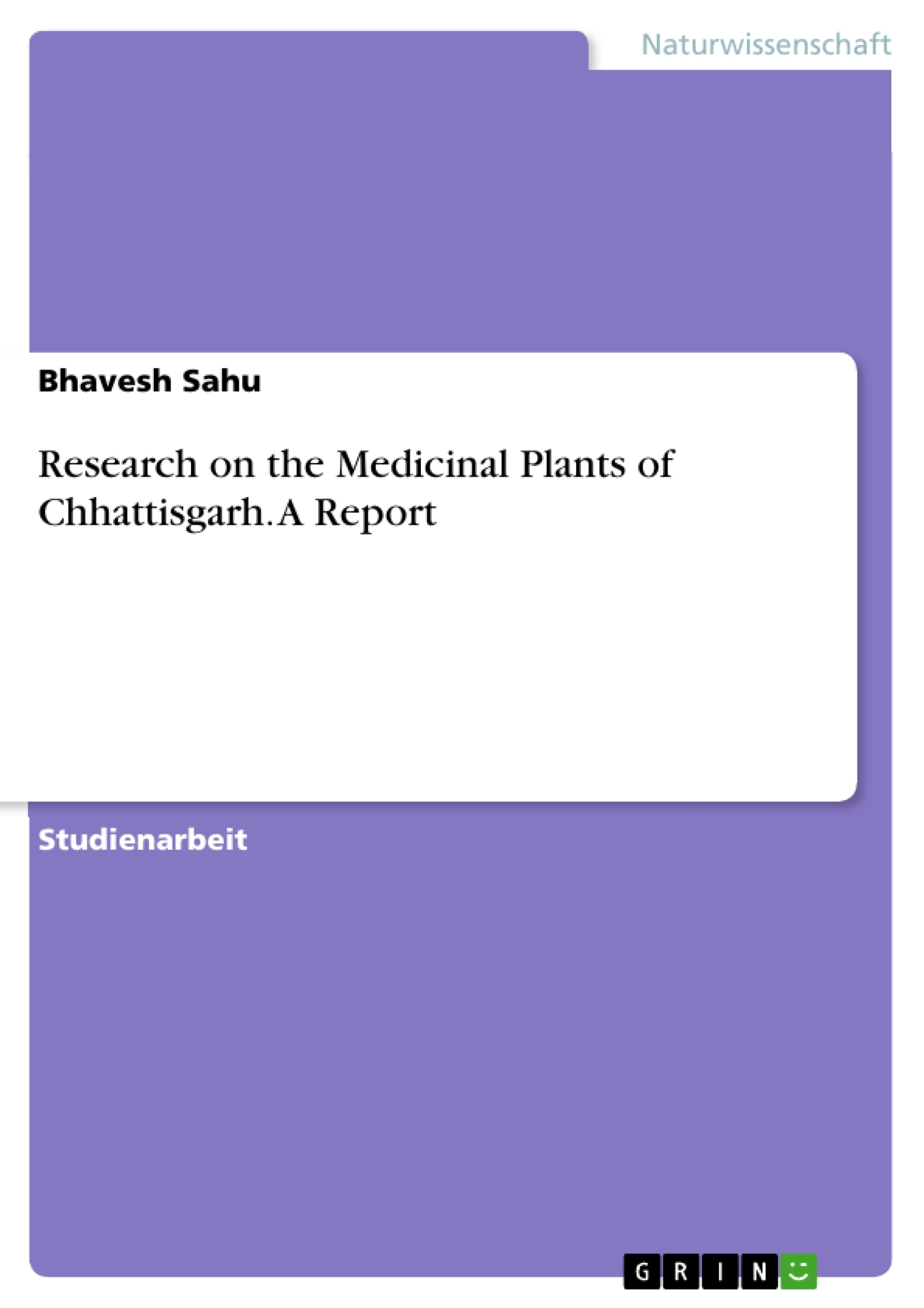This overview explores the significant medicinal plants of Chhattisgarh and highlights their cultural value, potential therapeutic applications, and sustainable use. This overview discusses the pharmacological characteristics and potential therapeutic effects of selected medicinal plants from Chhattisgarh's biological and chemical components. These herbs have historically been used to treat a variety of conditions, including cutaneous, respiratory, gastrointestinal, and chronic illnesses. This overview also focuses on recent scientific studies and investigations that support the effectiveness of these plants and their extracts and open the road for their incorporation into contemporary medicine.
Given the rising need for herbal medicines globally, this overview also takes into account the sustainable management and conservation of medicinal plants in Chhattisgarh. It looks at the initiatives taken by governmental and non-governmental organizations to encourage planting, conservation, and ethical harvesting methods. Such initiatives attempt to safeguard the long-term availability of these priceless medical resources while fostering local communities and wildlife preservation. The executive summary concludes by highlighting the domestic and global economic possibilities of Chhattisgarh's medicinal plants. Growing demand for natural and alternative treatments on a global scale offers a chance for the state's medicinal plant business to prosper.
To maintain the ecological integrity and cultural significance of these plants, a balance between commercialization and sustainability is essential. The report concludes by giving a thorough description of the medicinal plants that may be found in Chhattisgarh and highlighting their therapeutic value, folkloric knowledge, sustainable management methods, and economic potential. In addition to honouring nature's therapeutic abilities, this investigation will ethically combine Chhattisgarh's medicinal plant resources in order to advance humanity and protect nature's wealth for future generations.
Inhaltsverzeichnis
- 1. INTRODUCTION
- 1.1 Religion and Rationale
- 1.2 Chhattisgarh: As a Herbal State
- 2. COMMON DISEASE OF CHHATTISGARH
- 2.1 Malaria
- 2.2 Dengue Fever
- 2.3 Tuberculosis
- 2.4 Diarrheal
- 2.5 Respiratory Infection
- 3. MATHADOLOGY
- 3.1 Study Area
- 3.2 Sampling and Collection Site
- 3.2.1.Forest Reserve
- 3.2.2. Tribal and Rural Communities
- 3.2.3. Ecologically Important Zone
- 3.2.4. Different Forest Types
- 3.2.5. Geographically Diverse Location
- 3.3 Data Collection Methods
- 3.3.1. Field Survey
- 3.3.2. Collection Of Herbarium Specimens
- 3.3.3. Interviews and Traditional Knowledge
- 3.3.4. Ethnobotany
- 3.3.5. Literature Review
- 3.4 Plant Identification and Documentation
- 3.4.1. Amar Beal
- 3.4.2. Baheda
- 3.4.3. Chaolai Bhaji
- 3.4.4. Harra
- 3.4.5. Bhui Avala
- 3.4.6. Bhui Neem
- 3.4.7. Bis Tendu
- 3.4.8. Charota Bhaji
- 3.4.9. Mahua
- 3.4.10. Khair
- 4. TABLE OF MEDICINAL PLANT OF CHHATTISGARH
- 5. RESULT
- 6. DISSCUSION
- 6.1 Overview Of Medicinal Plant of Chhattisgarh
- 6.1.1. Medicinal Plant Diversity
- 6.1.2. Traditional Knowledge and Uses
- 6.1.3. Species Richness
- 6.2 Conservation Challenge
- 6.2.1. Habit Destruction and Fragmentation
- 6.2.2. Lack of Legal Protection and Enforcement
- 6.2.3. Lack of Awareness and Traditional Knowledge Transmission
- 6.3 Policy Recommendation
- 6.3.1. Conservation of Medicinal Plant Habitat
- 6.3.2. Research and Monitoring
- 6.3.3. Collaborative Partnerships
- 6.3.4. Continuous Monitoring and Policy review
Zielsetzung und Themenschwerpunkte
Die Dissertation befasst sich mit der Erforschung von Heilpflanzen in Chhattisgarh, Indien. Ziel ist es, die Vielfalt und Bedeutung dieser Pflanzen für die traditionelle Medizin und das Gesundheitswesen zu untersuchen. Dabei werden die kulturelle Bedeutung, die potenziellen therapeutischen Anwendungen und die nachhaltige Nutzung dieser Pflanzen beleuchtet.
- Vielfalt und Bedeutung der Heilpflanzen in Chhattisgarh
- Traditionelles Wissen und Anwendungen der Heilpflanzen
- Herausforderungen und Chancen im Bereich der Heilpflanzen-Konservierung
- Entwicklung von Strategien für eine nachhaltige Nutzung und den Schutz von Heilpflanzen
- Das Potential der Heilpflanzen aus Chhattisgarh für die moderne Medizin
Zusammenfassung der Kapitel
- Kapitel 1: Einführung - Die Einleitung erläutert die Bedeutung von Heilpflanzen und die Rolle von Chhattisgarh als ein Gebiet mit einer reichen botanischen Vielfalt. Es werden die Ziele der Dissertation und die Struktur des Textes dargelegt.
- Kapitel 2: Häufige Krankheiten in Chhattisgarh - Dieses Kapitel beleuchtet verschiedene häufige Krankheiten in Chhattisgarh, die durch Heilpflanzen behandelt werden können, wie z.B. Malaria, Dengue-Fieber, Tuberkulose, Durchfall und Atemwegsinfektionen.
- Kapitel 3: Methodik - Hier wird die Methodik der Forschung vorgestellt. Es werden die Studiengebiete, die Stichprobennahme, die Datenerhebungsmethoden und die Pflanzenidentifizierung beschrieben.
- Kapitel 4: Tabelle der Heilpflanzen von Chhattisgarh - Dieses Kapitel präsentiert eine detaillierte Auflistung von Heilpflanzen aus Chhattisgarh, einschließlich ihrer Eigenschaften und Anwendungen.
- Kapitel 5: Ergebnisse - In diesem Kapitel werden die Ergebnisse der Forschung präsentiert, wie z.B. die Identifizierung und Dokumentation der Heilpflanzen in Chhattisgarh.
- Kapitel 6: Diskussion - Die Diskussion analysiert die Ergebnisse und beleuchtet die Bedeutung der Heilpflanzen für die Gesundheit und das Wohlergehen der Bevölkerung. Es werden auch Herausforderungen im Zusammenhang mit der Konservierung dieser Pflanzen betrachtet.
Schlüsselwörter
Heilpflanzen, Chhattisgarh, Ethnobotanik, traditionelle Medizin, Artenvielfalt, Konservierung, nachhaltige Nutzung, pharmakologische Eigenschaften, therapeutische Anwendungen.
- Arbeit zitieren
- Bhavesh Sahu (Autor:in), 2023, Research on the Medicinal Plants of Chhattisgarh. A Report, München, GRIN Verlag, https://www.hausarbeiten.de/document/1472229


